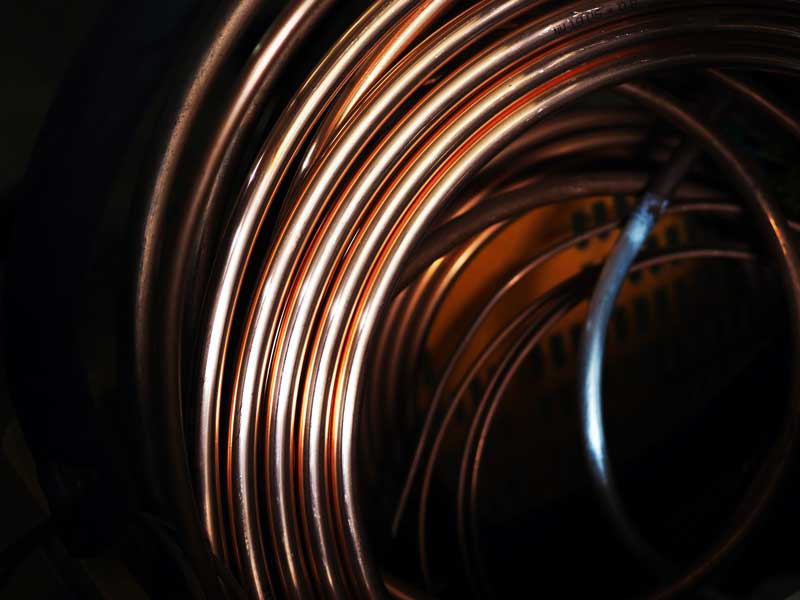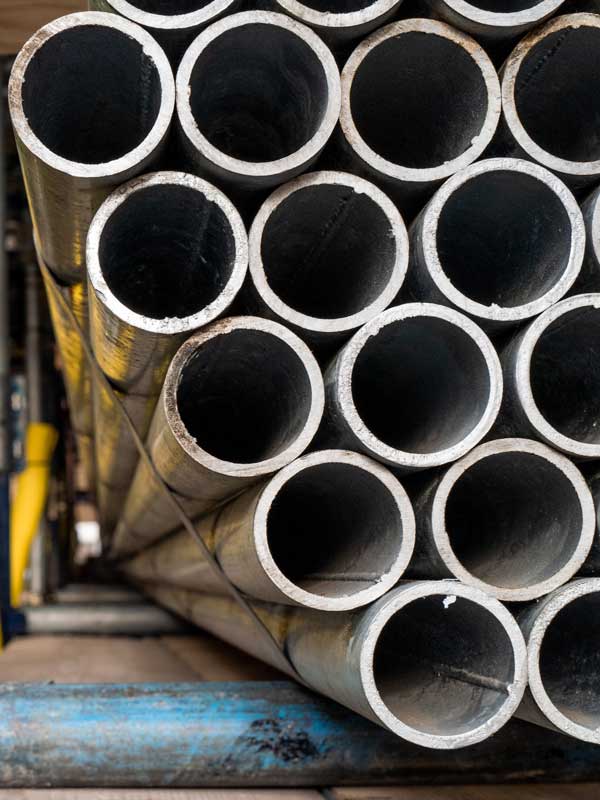Without pipes and tubes, many plumbing projects wouldn’t be made possible. So, what is the importance of knowing the different types of pipe and tube products? Well, very. The material, the type and the quality are just some of the things you need to consider when buying pipes and tubes. So, read this guide to discover more about the differences and learn what you need for your latest plumbing project as soon as possible.
Table of contents
- What is the difference between pipes and tubes?
- What are pipes?
- Types of plumbing pipe
- What are drainage tubes?
- Types of plumbing tube
- Pipe vs tube – which is better?
What is the difference between pipes and tubes?
Although the words ‘pipe’ and ‘tube’ may be used synonymously, they are unique products. Particularly when referring to measurements and shape(s). To identify the differences, you need to understand the qualities each has.
The short answer to this is as follows:
Pipes are always round, ‘tube-shaped’, and designed to distribute fluids and gases. They typically have measurements using the inside diameter and have a nominal pipe size (NPS or DN). This is a rough representation of the pipe’s conveyance capacity. It’s also worth noting the outside of a pipe is typically larger than the inside.
Tubes, on the other hand, can be round, rectangular, squared or even oval. Their hollow sections are measured using outside diameter (OD) and wall thickness (WT). These measurements are commonly conveyed in inches or millimetres. Their manufacturing methods are also stricter because of their varying range.
For the long answer, read on to find out more about how pipes and tubes vary.
What are pipes?
Starting with pipes, these usually carry certain fluids across a system. There is more than one type of pipe. Each pipe has different qualities to suit project requirements.
Years ago, (cast) iron and lead pipes were the go-tos for domestic plumbing systems. Cast iron was especially popular as a long-lasting, strong material – an unchanged feature to this day. That’s why it was a commonly used solution where pipework on the outside of buildings, such as soil pipe systems or guttering was required. So, if your house was built early on (even beyond the Second World War), your property may have cast iron somewhere on the property.
Nowadays, water is carried around homes through copper pipes, while plastic pipes are used for waste management.
Types of plumbing pipe
There are many different types of plumbing pipe materials to choose. Whichever you choose depends on what you will be using it for, as well as other typical factors that are personal to your project. This includes:
- Cost
- Longevity requirements
- Repairment considerations
Here’s a breakdown of the different types of pipe materials.
| Types of pipe material | Suitable for | Pros | Cons |
| Cast iron | •Water management systems. •Drain lines. •Vent lines. | •Durable. •Long-lasting. •Quiet performance (minimises sound of moving water). •Heat resistant. •Can be used in new or old homes. | •Less cost-effective. •Prone to rusting. •At risk of corrosion. •Heavy. •Difficult to cut. |
| Copper | •Water management systems in the home (sinks, showers, bathtubs etc). | •Not a health risk like other pipe materials. •Durable. •Corrosion resistant. •Can be used for hot and cold water temperatures. •Easy to cut using a tubing cutter or hacksaw. •Can be recycled. •Suitable for solder-type connection. | •Less cost-effective. •Not suitable for tight spaces due to rigid structure. •Soldering connection requires experience and safety protocols. |
| uPVC (polyvinyl chloride) (plastic) | •Waste management systems (sink, toilet or shower drain). | •Lightweight. •Easy to handle. •Cost-effective. •Durable. •Can handle high water pressures. •Easy to install. •Easy to cut using a hacksaw and mitre box. •Connected via gluing with solvents. •Smooth inner lining prevents sediment build-up and is blockage resistant. | •Limited sizes available. •Struggles to withstand hot water. •Toxicity is still a concern amongst usage for main water supply lines even if possible. •Requires confirmation with local regulations to check the code is suitable. |
| Galvanised steel | •Drainage. •Water supply (not used in new construction or remodel projects). •Gas supply. | •Durable. •Corrosion-resistant. •Both ends of the pipe are threaded. •Individual pipes are screwed into each other using connecting fittings. | •Not as common. •Less cost-effective. |
| ABS (acrylonitrile butadiene styrene) | •Vent lines. •Drain lines. | •Similar looking to PVC pipe. •Cost-effective. •Easy to install. •Sleek black colour for a smart, familiar pipe appearance. | •Less durable •Can warp and degrade due to sun exposure. •Limited colour options (black common). •Soft structure. •Noisy performance. •Requires confirmation with local regulations to check the code is suitable. |
| Flexi | •Final piping connections to appliances (Water heaters, toilets, sinks). | •Variety of lengths and sizes to available. •Not a lot of pipe is typically needed. | •Not suitable for use inside walls or floors. •Less durable. •Can fail after years of use due to wear and tear. •Less cost-effective. |
| PEX (cross-linked polyethene) (plastic) | •Water management systems. | •Durable. •Can withstand pressures of the water supply. •Can prevent rust or corrosion from leaking into water supply. •Flexibility allows fitting through walls, ceilings, basements and crawlspaces. •Cost-effective. •Common sizes include ½ inch and ¾ inch diameters. •Easy to cut. •Easy to join. •Colour coding of red and blue to indicate hot and cold water (red for hot; blue for cold). | •Requires confirmation with local code requirements before installation. •Must be efficiently supported. •Fittings must be tested and properly installed, especially when fitting behind walls. |

What are drainage tubes?
Now, when it comes to tubes, these can be more complicated. As mentioned in the short answer, a tube refers to the shape of the hollow sections. These shapes are:
- Round
- Square
- Rectangular
- Oval
They’re commonly used for pressure equipment, mechanical applications and instrumentation systems. Quite demanding applications. As such, strict standards are put in place to prevent issues from occurring.
Types of plumbing tube
Tube materials are limited, unlike pipes. The main reasons are that their uses are widely different. It’s also worth noting that tubes can be cold and hot-rolled. So, the requirements for each will differ. However, when choosing a material, you will still have to consider the following:
- Cost
- Longevity requirements
- Repairment considerations
Here’s a breakdown of the different types of tube materials.
| Types of tube material | Suitable for | Pros | Cons |
| Stainless steel | •Water management systems. •High-pressure applications (e.g. transporting gas). | •Resistant to stains. •Resistant to corrosion. •Durable. •Long-lasting. •Easy to maintain. •Easy to install. •Aesthetically pleasing in commercial applications. •Recyclable. •Does not need to be coated or lined with other materials. | •Less cost-effective. •Can fail after years of wear and tear. •Easily dirtied with smudges or fingerprints which end up visible (not ideal where appearance matters such as in a kitchen). |
| Carbon steel | •Water management systems. •Heating systems. •Transporting oil. •Transporting natural gas. | •Strong structure. •Can be bent and stretched in various positions without losing shape. •Can be manufactured thin. •Can withstand high-pressure flows. •Shock resistant. •Fire resistant. •Great for industrial applications. •Cost-effective. •Resistant to pest infestations. •Rot-resistant. •Recyclable. | •At risk of rusting over time. •Can corrode over time. |
| Low alloy steel | •Cross-country pipelines. | •Lightweight options available. •Tougher structure compared to carbon steels. •Corrosion resistant. •Bare or galvanised options. •Can withstand high temperatures. •High stress resistance. | •More less cost-effective than some other materials. •Can chip or break when used with machinery. •Low melting point making it difficult to weld or heat treat. |
| Nickel alloy | •Heat exchanger systems. •Process vessel systems. •High temperature applications. | •Long-lasting. •Corrosion resistant. •Chemical resistant. •Seawater resistant. •Heat resistant. •Ideal for industrial applications. •Low-rate thermal expansion. •Warp resistant. | •Corrosion resistance depends on the grade of the tubing. |

Pipe vs tube – which is better?
To summarise, there isn’t really a “better”. However, whichever you choose does depend on the type of project you use the pipes or tubes for. To highlight these key differences, we’ve provided a table for you to identify the key differences so you can make an informed decision.
| Pipe | Tube | |
| Shapes | •Round | •Round •Rectangular •Square •Oval |
| Materials | •Plastics •Metals | •Steels (carbon steel, low alloy, stainless steel and nickel alloys). •Steel tubes mostly manufactured with carbon steel used in mechanical applications. |
| Average cost | •Can be lower in some cases (I.e. steel pipes lower per ton than tubes). | •Lower mills productivity per hour and strict requirements contributes to higher costs (requirements referring to the tolerance and inspection process). |
| Strengths | •Not a primary concern. | •Mechanical strength is a primary concern. |
| Tolerance (straightness, dimensions, roundness etc) | •Tolerances are set but loose. | •Produced to strict tolerances, undergoing various quality checks for varying dimensions during the manufacturing process (straightness, roundness, wall thickness and surface). |
| End connections (most common) | •Bevelled •Plain •Screwed | •Threaded •Grooved (Enables quicker connections on site). |
| Important dimensions | •Outside diameter (OD) and wall thickness . •OD minus 2 times wall thickness (schedule) determines inside pipe diameter (ID), determining the liquid capacity of the pipe. •Nominal pipe size (NPS) is a rough indication and does not match the true diameter. | •Outside diameter (OD) and wall thickness. •Measurements expressed in inches or millimetres (mm). •Sizes are a true dimensional value of the hollow section. |
| Wall thickness | •Pipe thickness is assigned a “schedule” value. •Common schedule values include Sch 40, Sch. STD, Sch XD, SCH XXS. •If two pipes have different nominal pipe sizes (NPS) and the same schedule, both will have different wall thicknesses (identified in inches or millimetres (mm). | •Expressed in inches or millimetres (mm). •Wall thickness is also measured using a gauge nomenclature. |
| Size range | •Vast, reaching up to 80 inches and beyond. | •Minimal, reaching up to 5 inches. •Larger tube sizes are available for mechanical applications. |
| Process of production | •Typically made to stock. •Manufactured using automated and efficient processes (e.g. pipe mills producing pipes on a continuous scale, supplying products around the globe). | •Long and difficult manufacturing processes. |
Are you still not sure what size pipes you need? Explore our pipe and tube sizes guide for more information about the varying measurements for piping and tubing. We also have a variety of other plumbing guides to ensure you have the best advice to make an informed decision.





































